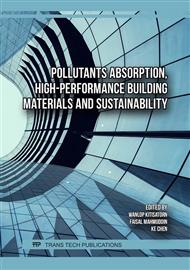[1]
G. Chen, P. Liu, T. Jiang, Z. He, X. Wang, L. Lam and J. F. Chen, "Effects of natural seawater and sea sand on the compressive behaviour of unconfined and carbon fibre-reinforced polymer-confined concrete," Advances in Structural Engineering, vol. 23, no. 14, p.3102–3116, 2020.
DOI: 10.1177/1369433220920459
Google Scholar
[2]
A. Dasar, H. Hamada, Y. Sagawa and D. Yamamoto, "Deterioration progress and performance reduction of 40-year-old reinforced concrete beams in natural corrosion environments," Construction and Building Materi, vol. 149, p.690–704, 2017.
DOI: 10.1016/j.conbuildmat.2017.05.162
Google Scholar
[3]
A. Dasar, D. Patah, H. Hamada, Y. Sagawa and D. Yamamoto, "Applicability of seawater as a mixing and curing agent in 4-year-old concrete," Construction and Building Materials, vol. 259, p.119692, 2020.
DOI: 10.1016/j.conbuildmat.2020.119692
Google Scholar
[4]
D. Patah, H. Hamada and D. Yamamoto, "The Effect of Seawater Mixing on Corrosion of Steel Bar in 36-Years Old Rc Beams Under Marine Tidal Environment,"Japan Concrete Institute,, vol. 41, no. 1, p.791–796, 2019.
Google Scholar
[5]
D. Patah and A. Dasar, "The Impact of using Rice Husks Ash, Seawater and Sea Sand on Corrosion of Reinforcing Bars in Concrete," Journal of the Civil Engineering Forum, pp.251-262, September, 2023.
DOI: 10.22146/jcef.6016
Google Scholar
[6]
J. G. Teng, Y. Xiang, T. Yu and Z. Fang, "Development and mechanical behaviour of ultra-high highperformance," Advances in Structural Engineering, vol. 22, no. 14, p.3100–3120, 2019.
DOI: 10.1177/1369433219858291
Google Scholar
[7]
B. X. Yang, T. Y. Xie, Y. Yu, Y. Zheng and J. J. Xu, "Mechanical properties and environmental performance of seawater sea-sand self-compacting Concrete," Advances in Structural Engineering, vol. 25, no. 15, pp.3114-3136, 2022.
DOI: 10.1177/13694332221119863
Google Scholar
[8]
S. Yin, Z. Liu and P. Dong, "Study on degradation of mechanical properties of BFRP bars wrapped with seawater sea sand concrete under chloride dry wet cycle," Construction and Building Materials, vol. 352, p.129050, 2022.
DOI: 10.1016/j.conbuildmat.2022.129050
Google Scholar
[9]
M. Arezoumandi and J. S. Volz, "Effect of fly ash replacement level on the shear strength of high high volume," Journal of Cleaner Production, vol. 59, p.120–130, 2013.
DOI: 10.1016/j.jclepro.2013.06.043
Google Scholar
[10]
C. D. Atiş and O. Karahan, "Properties of steel fiber reinforced fly ash concrete," Construction and Building Materials, vol. 23, no. 1, p.392–399, 2009.
DOI: 10.1016/j.conbuildmat.2007.11.002
Google Scholar
[11]
W. J. Halstead, "USE OF FLY ASH IN CONCRETE," NCHRP Synthesis of Highway Practice, p.127, 1986.
Google Scholar
[12]
R. A. Helmuth, "FLY ASH IN CEMENT AND CONCRETE," p.203, 1987.
Google Scholar
[13]
M. Limbachiya, M. S. Meddah and Y. Ouchagour, "Use of recycled concrete aggregate in fly-ash concrete concrete," Construction and Building Materials, vol. 27, no. 1, p.439–449, 2012.
DOI: 10.1016/j.conbuildmat.2011.07.023
Google Scholar
[14]
V. M. Malhotra, "High-Performance High-Volume Fly Ash Concrete," Concrete International,, vol. 24, no. 7, p.30–34., 2002.
Google Scholar
[15]
P. Nath and P. Sarker, "Effect of Fly Ash on the Durability Properties of High Strength Concrete," Procedia Engineering, vol. 14, p.2011, 1149–1156.
DOI: 10.1016/j.proeng.2011.07.144
Google Scholar
[16]
D. Patah, A. Dasar, Apriansyah and M. A. Caronge, "Strength Development of Seawater Mixed and Cured Concrete with Various Replacement Ratios of Fly Ash," Materials Science Forum, vol. 1091, pp.111-118, 2023.
DOI: 10.4028/p-1ckry6
Google Scholar
[17]
R. Siddique, "Performance characteristics of high-volume Class F fly ash concrete," Cement and Concrete Research, vol. 34, no. 3, p.487–493, 2004.
DOI: 10.1016/j.cemconres.2003.09.002
Google Scholar
[18]
Badan Standardisasi Nasional (BSN), SNI 15-7064-2004: Semen Portland komposit, Jakarta: Standar Nasional Indonesia, 2004.
Google Scholar
[19]
ASTM Committee C-09, Concrete and Concrete Aggregates: Standard specification for coal fly ash and raw or calcined natural pozzolan for use in concrete, ASTM international, 2013.
DOI: 10.1520/c0618-00
Google Scholar
[20]
D. Patah and A. Dasar, "Pasir dan Kerikil Sungai Mappili sebagai material Lokal untuk Campuran Beton di Sulawesi Barat," BANDAR: JOURNAL OF CIVIL ENGINEERING, vol. 3, no. 2, pp.9-14, 2021.
Google Scholar
[21]
BS EN 12350-2-2009, Testing fresh concrete Part 2: Slump test, British Standards Institution, 2009.
Google Scholar
[22]
ASTM, ASTM C876 - 15: Standard test method for corrosion potentials of uncoated reinforcing steel in concrete, 2015.
Google Scholar
[23]
A. Dasar, H. Hamada, Y. Sagawa and R. Irmawaty, "Corrosion Evaluation of Reinforcing Bar in Sea Water Mixed Mortar by Electrochemical Method," Proceedings of the Japan Concrete Institute, p.889–894, 2013.
Google Scholar
[24]
A. Dasar, H. Hamada, Y. Sagawa and D. Yamamoto, "RECOVERY IN MIX POTENTIAL AND POLARIZATION RESISTANCE OF STEEL BAR IN CEMENT HARDENED MATRIX DURING EARLY AGE OF 6 MONTHS-SEA-WATER MIXED MORTAR AND CRACKED CONCRETE," Proceedings of the Japan Concrete Institute, p.1203–1208, 2016.
Google Scholar
[25]
A. Dasar, H. Hamada, Y. Sagawa and D. Yamamoto, "ELECTROCHEMICAL BEHAVIOR OF STEEL IN CRACKED CONCRETE–INFLUENCE OF CRACK WIDTH, COVER, EXPOSURE CONDITIONS AND SUPPLEMENTARY CEMENTITIOUS MATERIALS (SCMs)," Proceedings of the Japan Concrete Institute, p.1045–1050, 2017.
Google Scholar
[26]
S. H. Kosmatka, B. Kerkhoff and C. P. William, "Design and control of concrete mixtures," IL: Portland Cement Association, vol. 5420, pp.60077-1083, 2022.
Google Scholar
[27]
A. Maryoto, "Penurunan Nilai Half Cell Potential Beton Dengan Bahan Tambah Fly Ash Dan Ca(C18H35O2)2," Dinamika Rekayasa, vol. 10, no. 2, pp.45-49, 2014.
Google Scholar



